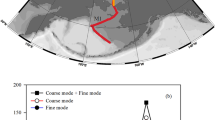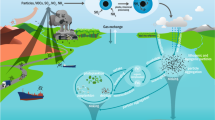Abstract
Although abundant in the Earth’s crust, iron is present at trace concentrations in sea water and is a limiting nutrient for phytoplankton in approximately 40% of the ocean1,2. Current literature suggests that aerosols are the primary external source of iron to offshore waters, yet controls on iron aerosol solubility remain unclear3,4. Here we demonstrate that iron speciation (oxidation state and bonding environment) drives iron solubility in arid region soils, glacial weathering products (flour) and oil combustion products (oil fly ash). Iron speciation varies by aerosol source, with soils in arid regions dominated by ferric (oxy)hydroxides, glacial flour by primary and secondary ferrous silicates and oil fly ash by ferric sulphate salts. Variation in iron speciation produces systematic differences in iron solubility: less than 1% of the iron in arid soils was soluble, compared with 2–3% in glacial products and 77–81% in oil combustion products, which is directly linked to fractions of more soluble phases. We conclude that spatial and temporal variations in aerosol iron speciation, driven by the distribution of deserts, glaciers and fossil-fuel combustion, could have a pronounced effect on aerosol iron solubility and therefore on biological productivity and the carbon cycle in the ocean.
This is a preview of subscription content, access via your institution
Access options
Subscribe to this journal
Receive 12 print issues and online access
$259.00 per year
only $21.58 per issue
Buy this article
- Purchase on Springer Link
- Instant access to full article PDF
Prices may be subject to local taxes which are calculated during checkout



Similar content being viewed by others
References
Martin, J. H., Gordon, R. M. & Fitzwater, S. E. The case for iron. Limnol. Oceanogr. 36, 1793–1802 (1991).
Moore, J. K., Doney, S. C., Glover, D. M. & Fung, I. Y. Iron cycling and nutrient-limitation patterns in surface waters of the World Ocean. Deep-Sea Res. I 49, 463–507 (2002).
Mahowald, N. M. et al. Atmospheric global dust cycle and iron inputs to the ocean. Glob. Biogeochem. Cycles 19, gb4025 (2005).
Luo, C. et al. Combustion iron distribution and deposition. Glob. Biogeochem. Cycles 22, gb1012 (2008).
Jickells, T. D. et al. Global iron connections between desert dust, ocean biogeochemistry, and climate. Science 308, 67–71 (2005).
Lam, P. J. & Bishop, J. K. B. The continental margin is a key source of iron to the HNLC North Pacific Ocean. Geophys. Res. Lett. 35, L07608 (2008).
Sedwick, P. N., Sholkovitz, E. R. & Church, T. M. Impact of anthropogenic combustion emissions on the fractional solubility of aerosol iron: Evidence from the Sargasso Sea. Geochem. Geophys. Geosyst. 8, gc001586 (2007).
Wu, J., Rember, R. & Cahill, C. Dissolution of aerosol iron in the surface waters of the North Pacific and North Atlantic oceans as determined by a semicontinuous flow-through reactor method. Glob. Biogeochem. Cycles 21, gb4010 (2007).
Desboeufs, K. V., Sofikitis, A., Losno, R., Colin, J. L. & Ausset, P. Dissolution and solubility of trace metals from natural and anthropogenic aerosol particulate matter. Chemosphere 58, 195–203 (2005).
Hinkley, T. K. Composition and sources of atmospheric dusts in snow at 3200 meters in the St-Elias-Range, Southeastern Alaska, USA. Geochim. Cosmochim. Acta 58, 3245–3254 (1994).
Desboeufs, K. V., Losno, R. & Colin, J. L. Factors influencing aerosol solubility during cloud processes. Atmos. Environ. 35, 3529–3537 (2001).
Aguilar-Islas, A. M., Wu, J. & Rember, R. Dissolution of aerosol-derived iron in seawater: The influence of aerosol type and dissolved iron size fractionation. Mar. Chem. (in the press).
Plafker, G., Nokleberg, W. J. & Lull, J. S. Bedrock geology and tectonic evolution of the Wrangellia, Peninsular, and Chugach Terranes along the Trans-Alaska Crustal Transect in the Chugach Mountains and Southern Copper River Basin, Alaska. J. Geophys. Res. 94, 4255–4295 (1989).
Journet, E., Desboeufs, K. V., Caquineau, S. & Colin, J. L. Mineralogy as a critical factor of dust iron solubility. Geophys. Res. Lett. 35, L07805 (2008).
Spokes, L. J., Jickells, T. D. & Lim, B. Solubilization of aerosol trace-metals by cloud processing—a laboratory study. Geochim. Cosmochim. Acta 58, 3281–3287 (1994).
O’Day, P. A., Rivera, N., Root, R. & Carroll, S. A. X-ray absorption spectroscopic study of Fe reference compounds for the analysis of natural sediments. Am. Mineral. 89, 572–585 (2004).
Cwiertny, D. M. et al. Characterization and acid-mobilization study of iron-containing mineral dust source materials. J. Geophys. Res. 113, D05202 (2008).
Jenny, H. Factors of Soil Formation; a System of Quantitative Pedology (McGraw-Hill, 1941).
Fan, S. M., Moxim, W. J. & Levy, H. Aeolian input of bioavailable iron to the ocean. Geophys. Res. Lett. 33, L07602 (2006).
Michel, F. M. et al. The structure of ferrihydrite, a nanocrystalline material. Science 316, 1726–1729 (2007).
Anders, A. M., Sletten, R. S., Derry, L. A. & Hallet, B. Germanium/silicon ratios in the Copper River Basin, Alaska: Weathering and partitioning in periglacial versus glacial environments. J. Geophys. Res. 108, F16005 (2003).
Cornell, R. M. & Schwertmann, U. The Iron Oxides (Wiley–VCH, 2003).
Prudencio, M. I. et al. Clay mineral assemblages in weathered basalt profiles from central and southern Portugal: Climatic significance. Catena 49, 77–89 (2002).
Boyd, P. W. et al. Atmospheric iron supply and enhanced vertical carbon flux in the NE subarctic Pacific: Is there a connection? Glob. Biogeochem. Cycles 12, 429–441 (1998).
Jerz, J. K. & Rimstidt, J. D. Efflorescent iron sulfate minerals: Paragenesis, relative stability, and environmental impact. Am. Mineral. 88, 1919–1932 (2003).
Eglinton, T. I. et al. Composition, age, and provenance of organic matter in NW African dust over the Atlantic Ocean. Geochem. Geophys. Geosyst. 3, gc1050 (2002).
Seggiani, M., Vitolo, S., Pastorelli, M. & Ghetti, P. Combustion reactivity of different oil-fired fly ashes as received and leached. Fuel 86, 1885–1891 (2007).
Buck, C. S., Landing, W. M., Resing, J. A. & Lebon, G. T. Aerosol iron and aluminum solubility in the northwest Pacific Ocean: Results from the 2002 IOC cruise. Geochem. Geophys. Geosyst. 7, Q04m07 (2006).
Webb, S. M. SixPACK: A graphical user interface for XAS analysis using IFEFFIT. Phys. Scripta T 115, 1011–1014 (2005).
Wilke, M., Farges, F., Petit, P. E., Brown, G. E. & Martin, F. Oxidation state and coordination of Fe in minerals: An Fe K-XANES spectroscopic study. Am. Mineral. 86, 714–730 (2001).
Acknowledgements
This project was financially supported as part of a Mendenhall Postdoctoral Fellowship awarded to A.W.S. by the US Geological Survey (USGS) and financial support to A.W.S. and J.C. by the Coastal and Marine Geology and Earth Surface Dynamics Programs of the USGS. E.R.S. was supported by NSF. Synchrotron work was done on beamline 11-2 at Stanford Synchrotron Radiation Laboratory (SSRL): a national user facility operated by Stanford University on behalf of the Department of Energy, Office of Basic Sciences. We thank SSRL staff for their help, particularly J. Bargar and J. Rogers, as well as S. Birdwhistell of the WHOI Plasma Facility. Discussions with A. Aguilar-Islas, K. Bruland, J. Bratton, A. Kolker, P. Lam and O. Rouxel improved this manuscript. We thank B. Puecker-Ehrenbrink and M. Seggiani for providing us with samples of Chinese loess and oil fly ash, respectively.
Author information
Authors and Affiliations
Contributions
A.W.S., J.C. and E.R.S. designed the study. A.W.S. and J.C. conducted the leaching experiments. A.W.S. interpreted the leach data with input from J.C. and E.R.S. A.W.S. and B.C.B. collected and interpreted XAS spectra. A.W.S. wrote the manuscript with valuable input from all authors.
Corresponding author
Supplementary information
Supplementary Fig. S1
Supplementary Information (PDF 220 kb)
Rights and permissions
About this article
Cite this article
Schroth, A., Crusius, J., Sholkovitz, E. et al. Iron solubility driven by speciation in dust sources to the ocean. Nature Geosci 2, 337–340 (2009). https://doi.org/10.1038/ngeo501
Received:
Accepted:
Published:
Issue Date:
DOI: https://doi.org/10.1038/ngeo501
This article is cited by
-
Size-dependent aerosol iron solubility in an urban atmosphere
npj Climate and Atmospheric Science (2022)
-
Subaerial volcanism is a potentially major contributor to oceanic iron and manganese cycles
Communications Earth & Environment (2022)
-
Stable iron isotopic composition of atmospheric aerosols: An overview
npj Climate and Atmospheric Science (2022)
-
The mineralogical composition of coarse and fine particulate material, their fate, and sources in an industrialized region of southeastern Brazil
Environmental Monitoring and Assessment (2022)
-
Ocean fertilization by pyrogenic aerosol iron
npj Climate and Atmospheric Science (2021)



